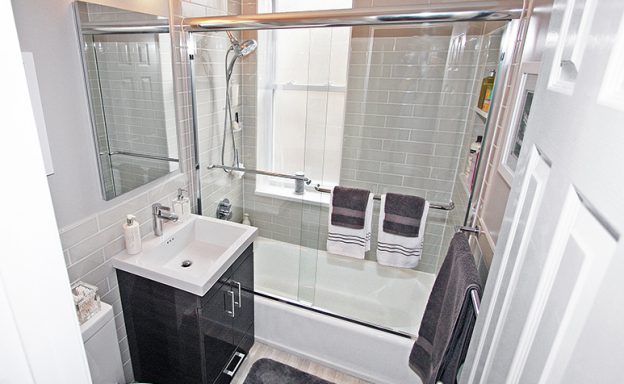A game of inches saved this small New York City bathroom from becoming too cramped and limited.
Liz Weingart knew something was wrong when the man on the other end of the telephone addressed her as Elizabeth, her full first name. Weingart, then an investment banker and marketer, was on a business trip in California at the time. Her upstairs neighbor’s toilet had overflowed, said the superintendent of the New York City co-op building where Weingart had lived for two decades. The damage was extensive.
Because nobody was home in either unit, and because the toilet was an older, tankless model that connected directly to the main plumbing, water poured through Weingart’s walls for 10 hours, destroying her compact 5- by 7-foot bathroom and spaces in several units below hers. She cut her trip short, immediately hopped a flight back to New York and several hours later opened the door to her apartment to find the stench of water saturation overwhelming.
She had to race the clock to prevent mold and mildew. She hired a restoration company to punch silver-dollar-sized holes in the walls, which they then blasted with massive heaters. “My wall looked like Swiss cheese,” she says. The company also brought in devices that read the water content of plaster. The readouts showed 100 percent saturation.
BEFORE: Once things were dried out, Weingart hired a contractor to come in and temporarily seal everything up so she could at least use the bathroom while she planned her next move.

Weingart got insurance money for the damage, but the $12,000 fell quite short of the cheapest mold restoration and renovation she could do, she says. “It didn’t account for replacing the plumbing, which most co-ops require,” she adds.
This is her previous bathroom shown here just after she cleaned up the remaining water. The building was built in 1938 and became a co-op in 1990. The sponsors at the time renovated some of the apartments to sell quickly, so things were cheaply done. Beige tiles on the floor and walls made the room look bigger but not better. “I could have spent less money and replaced everything with the same 50-cent tile,” she says. “But no one wants to do that. I wanted to love my new bathroom.”
AFTER: Weingart used to be the president of her co-op building and says she had time to think about her small space. She knew what would be permitted and what wouldn’t. Her plumbing could not move. And after measuring the vanity, toilet and other pieces in her original bathroom, she knew what she had room for.

She decided to design her new bathroom herself, sourcing all the tile, fixtures and finishes, a task that proved immensely challenging. She scoured local showrooms in search of small sinks, vanities, toilets and more. She played a game of inches, mapping out every decision carefully to get the most storage and counter space in her bathroom.
Weingart even showed up at toilet showrooms with a tissue box in hand in search of a flat-topped toilet tank she could put the box on. The dozens of toilets she looked at had either curved tanks or dual-flush buttons in the center. She eventually found a one-piece flat-top model by DXV called the Seagram that supported a tissue box just fine.
[You can finish reading the article at Houzz.com. Click here.]





